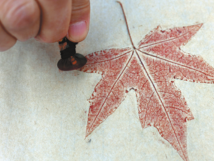Tree leaves inject life into old artform
Updated: 2022-12-02

An example of leaf rubbing by Cao Xiumin. [Photo provided to China Daily]
Long before copying machines were invented, the ancient Chinese had come up with a way to replicate patterns, drawings or characters engraved on oracle bones, bronze ware and stone tablets.
The tools for such an art were quite simple: a piece of rice paper, ink and a cloth ball or brush. The artists first covered the inscriptions with a piece of rice paper, and then tamped down on the paper into the inscriptions with a cloth ball soaked in light ink. When the paper was peeled off, the rubbings would be imprinted. This was something similar to children tracing a coin's patterns with pencil and paper.
To this day, rubbing is still a popular art in the circles of Chinese calligraphers and painters, who want to have copies of calligraphic and painting works rubbed from ancient relics to study, imitate or just to enjoy.
Cao Xiumin, 54, is a renowned rubbing artist in Taiyuan, Shanxi province. She has been working in this trade for more than three decades. Her works have been collected by calligraphers, painters and museums throughout the country.
But it was in recent years that she targeted tree leaves with remarkable vein patterns for her rubbing works.
In 2020, Cao began to collect maple, bamboo, ginkgo and bodhi leaves as the objects for rubbing.
It is popular among Chinese people to use leaves with unique vein patterns as bookmarks and as the ornaments or backgrounds for painting and calligraphic works. Cao found that dried leaves are not easy to preserve but the rubbings can last long.
"Theoretically, the rubbing of leaves is similar to working on hard objects like stone tablets, but the use of the hand's strength and the selection of paper are quite different," Cao said. She added that more subtle skills are needed to produce fine works.
Dozens of artists in Shanxi and China are creating miniature works of calligraphy or painting on the rubbings made by Cao, praising her for "rendering a new, long-lasting life to the leaves that were so easy to perish".
Zhong Qing contributed to this story.



